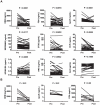Identification of novel biomarkers in seasonal allergic rhinitis by combining proteomic, multivariate and pathway analysis
- PMID: 21887273
- PMCID: PMC3160968
- DOI: 10.1371/journal.pone.0023563
Identification of novel biomarkers in seasonal allergic rhinitis by combining proteomic, multivariate and pathway analysis
Abstract
Background: Glucocorticoids (GCs) play a key role in the treatment of seasonal allergic rhinitis (SAR). However, some patients show a low response to GC treatment. We hypothesized that proteins that correlated to discrimination between symptomatic high and low responders (HR and LR) to GC treatment might be regulated by GCs and therefore suitable as biomarkers for GC treatment.
Methodology/principal findings: We identified 953 nasal fluid proteins in symptomatic HR and LR with a LC MS/MS based-quantitative proteomics analysis and performed multivariate analysis to identify a combination of proteins that best separated symptomatic HR and LR. Pathway analysis showed that those proteins were most enriched in the acute phase response pathway. We prioritized candidate biomarkers for GC treatment based on the multivariate and pathway analysis. Next, we tested if those candidate biomarkers differed before and after GC treatment in nasal fluids from 40 patients with SAR using ELISA. Several proteins including ORM (P<0.0001), APOH (P<0.0001), FGA (P<0.01), CTSD (P<0.05) and SERPINB3 (P<0.05) differed significantly before and after GC treatment. Particularly, ORM (P<0.01), FGA (P<0.05) and APOH (P<0.01) that belonged to the acute phase response pathway decreased significantly in HR but not LR before and after GC treatment.
Conclusions/significance: We identified several novel biomarkers for GC treatment response in SAR with combined proteomics, multivariate and pathway analysis. The analytical principles may be generally applicable to identify biomarkers in clinical studies of complex diseases.
Conflict of interest statement
Figures



Similar articles
-
A pathway-based approach to find novel markers of local glucocorticoid treatment in intermittent allergic rhinitis.Allergy. 2011 Jan;66(1):132-40. doi: 10.1111/j.1398-9995.2010.02444.x. Allergy. 2011. PMID: 20659080
-
Combined multivariate and pathway analyses show that allergen-induced gene expression changes in CD4+ T cells are reversed by glucocorticoids.PLoS One. 2012;7(6):e39016. doi: 10.1371/journal.pone.0039016. Epub 2012 Jun 12. PLoS One. 2012. PMID: 22701743 Free PMC article.
-
Leukotriene A4 Hydrolase Is a Candidate Predictive Biomarker for Successful Allergen Immunotherapy.Front Immunol. 2020 Nov 24;11:559746. doi: 10.3389/fimmu.2020.559746. eCollection 2020. Front Immunol. 2020. PMID: 33329520 Free PMC article.
-
Fluticasone furoate nasal spray in allergic rhinitis.Drugs Today (Barc). 2008 Apr;44(4):251-60. doi: 10.1358/dot.2008.44.4.1173289. Drugs Today (Barc). 2008. PMID: 18536783 Review.
-
A review of the efficacy of desloratadine, fexofenadine, and levocetirizine in the treatment of nasal congestion in patients with allergic rhinitis.Clin Ther. 2009 May;31(5):921-44. doi: 10.1016/j.clinthera.2009.05.017. Clin Ther. 2009. PMID: 19539095 Review.
Cited by
-
[Application of proteomics in allergic rhinitis].Lin Chuang Er Bi Yan Hou Tou Jing Wai Ke Za Zhi. 2022 Feb;36(2):153-157. doi: 10.13201/j.issn.2096-7993.2022.02.017. Lin Chuang Er Bi Yan Hou Tou Jing Wai Ke Za Zhi. 2022. PMID: 35172557 Free PMC article. Review. Chinese.
-
Proteomic features characterization of Hymenoptera venom allergy.Allergy Asthma Clin Immunol. 2019 Nov 27;15:77. doi: 10.1186/s13223-019-0387-5. eCollection 2019. Allergy Asthma Clin Immunol. 2019. PMID: 31798646 Free PMC article.
-
Insights into glucocorticoid responses derived from omics studies.Pharmacol Ther. 2021 Feb;218:107674. doi: 10.1016/j.pharmthera.2020.107674. Epub 2020 Sep 8. Pharmacol Ther. 2021. PMID: 32910934 Free PMC article. Review.
-
Apolipoprotein E and Periostin Are Potential Biomarkers of Nasal Mucosal Inflammation. A Parallel Approach of In Vitro and In Vivo Secretomes.Am J Respir Cell Mol Biol. 2020 Jan;62(1):23-34. doi: 10.1165/rcmb.2018-0248OC. Am J Respir Cell Mol Biol. 2020. PMID: 31194918 Free PMC article.
-
A generally applicable translational strategy identifies S100A4 as a candidate gene in allergy.Sci Transl Med. 2014 Jan 8;6(218):218ra4. doi: 10.1126/scitranslmed.3007410. Sci Transl Med. 2014. PMID: 24401939 Free PMC article.
References
-
- Bousquet J, Schunemann HJ, Zuberbier T, Bachert C, Baena-Cagnani CE, et al. Development and implementation of guidelines in allergic rhinitis - an ARIA-GA2LEN paper. Allergy. 2010;65:1212–1221. - PubMed
-
- Barnes PJ, Adcock IM. Glucocorticoid resistance in inflammatory diseases. Lancet. 2009;373:1905–1917. - PubMed
-
- Diamant Z, Boot JD, Mantzouranis E, Flohr R, Sterk PJ, et al. Biomarkers in asthma and allergic rhinitis. Pulm Pharmacol Ther. 2010;23:468–481. - PubMed
-
- Wang WY, Boot JD, Mascelli MA, Gerth van Wijk R, Diamant Z. Comparison of biomarkers between allergic rhinitis only and allergic rhinitis with concomitant asthma. Allergy. 2009;64:1102–1103. - PubMed
Publication types
MeSH terms
Substances
LinkOut - more resources
Full Text Sources
Medical
Research Materials
Miscellaneous

